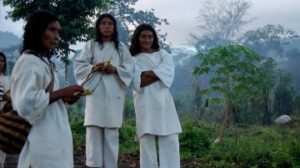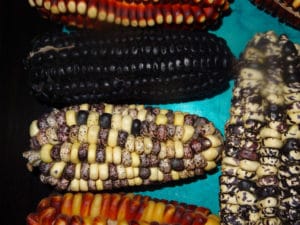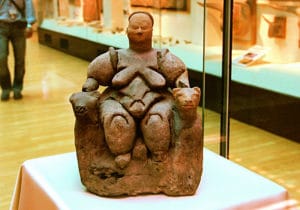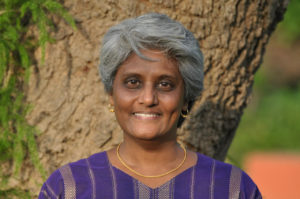
Lost and Found in Eden – Part III
by Usha Alexander
[ Lost and Found in Eden – Part II is here.]
[This is the fifth in a series of essays On Climate Truth and Fiction, in which I raise questions about environmental distress, the human experience, and storytelling. It first appeared on 3 Quarks Daily. This fifth essay is divided into three parts. The fourth essay in the series, called ‘Tales from a Changing World’ is here.]
The Dropped Subplots
As I intimated at the start, this trajectory we’ve ultimately followed as a global civilization—toward increasing inequity, greater despoliation of the commons, and the eradication or oppressive control of natural life within our acculturated spaces—was not the only drama under the sun. A few farming societies followed alternate routes, though all of these are now marginalized or obliterated. The aggressive creep of our dominant model of extraction and growth, which seems to have arisen and spread from the first urbanized societies, requires ever more energy, land, and water to feed itself, ultimately, directly or indirectly, devouring all others.
It appears, for instance, that the peoples of the Indus Valley Civilization (IVC), which flourished across what is today eastern Pakistan and northwestern India, between six and four thousand years ago, avoided developing a highly stratified society, compared to the Mesopotamians, with whom they regularly traded. Although much remains mysterious about the IVC, there’s no evidence that their city-states maintained standing armies, that their leaders hoarded great wealth, or that their populace toiled under the coercion of hallowed dynasties in the usual manner of similar polities across the globe. The eventual demise of their civilization may have been due either to seismic events that shifted the courses of rivers on which they depended, or to such enlargement of their urban population that they struggled to feed themselves when the local climate became drier, forcing them to abandon their cities. But their example still suggests it’s possible to create more egalitarian settled societies than what we might presume, based around a wholly different set of values.
Across Australia, Aboriginal and Torres Straits Islander peoples are known to have domesticated at least nineteen indigenous crops, in some cases planting them over miles at a stretch, without the use of animal labor, metal plows, or water diversions. Though some groups were fully sedentary, an ongoing reliance upon wild foods required continued and sustainable landscape management and modest human population sizes; their villages never grew into cities, remaining at fewer than a thousand people per settlement. The Haudenosaunee (Iroquois Confederacy) of North America, built fully sedentary villages of under a thousand, limiting environmental damage through a practice of rotating land use and other strategic management. Their larger villages, housing up to several thousand people, slowly migrated to new locations every few decades, rewilding their former village sites.

Like the Tairona (and later Kogi), the Haudenosaunee also never abandoned their understanding of and concern for environmental balance, which they realized underwrote their flourishing. In pre-Colonial times, neither had enslaved animals for food or labor, practiced mono-culture farming, nor diverted rivers. Neither developed dominant patriarchal institutions or the deep social hierarchies found among agricultural societies whose populations were concentrated into dense city-states. Despite being partly or fully sedentary, they continued to rely upon wild resources and to cultivate sustainable farming and landscape management practices. The Haudenosaunee abided by a core principle they call the Seventh Generation, according to which all major decisions taken must allow sustainability in consideration of those yet unborn. Thus, they eschewed short-term enrichment schemes causing despoliations that could threaten their future well-being. The Kogi are guided by the principle that whenever something is taken from the Earth, something must also be given back; they speak of making “payments” to the Earth.
While there is no perfect society nor any ancient system that can today sustain eight billion people on a planet with a rapidly collapsing biome, surely there are lessons here, among these paths not taken by the juggernaut of our modern civilization—if not to be emulated precisely, at least to remind us how broad is our potential. Such examples might help open our imagination to new possibilities for a future under the changing constraints of the planet. There’s no question we have much to learn about conservation and sustainability from peoples who have retained their close-to-nature ways of life. Even the IPCC promotes restoring indigenous land rights as a way to help mitigate climate change, recognizing that indigenous peoples manage their lands more sustainably than the rest of us. Any attempt to limit global temperature rise and preserve as much as we can of the existing biome may depend upon us adjusting our dominant paradigms to parallel theirs, even as we use new tools and methods to achieve similar ends.
Another Plot Twist?

The winding road that lead to the modern world—all that was lost and all that was gained along the way—demonstrates that our current planetary predicament isn’t a superficial modern phenomenon with a superficial remedy. Most certainly, ecological destruction and global warming have been egregiously accelerated over the past two hundred and fifty years, as the mining and mass burning of fossil fuels have inflamed our hyper-growth. But our modern predicament is merely the logical conclusion of a far older trend that begins with that fundamental shift in the human experience permitted by the Holocene: away from being subject to nature, toward the control of nature; away from balance, toward growth. It flows directly from a chain of choices made in pursuit of short-term prosperity, lured by immediate gratification, status-seeking, and other such inducements to which most humans seem especially vulnerable. Our predicament follows from the collective loss of our visceral understanding of nature and is enabled by the advancement of an alternate constellation of beliefs—stories that place humanity outside nature and valorize our acquisition of material goods and technological power as their own ends.
Our modern economies of efficient extraction and growth have no doubt provisioned a wealth of “affordable,” labor- and life-saving devices and products. I cannot regret the knowledge and security and longevity all this has made possible for most people alive today. Yet nor can I ignore the unintended consequences of this revolution, which has so changed our world—both our subjective experiences of it and its geophysical reality—that the world we’ve known and mastered now crumbles away within our grip, as species die off en masse and global temperatures dangerously rise. But this is not the end of our story of discovery. And we are not limited to doubling-down on the choices that have led us here. There is greater possibility within the human experience than those we acknowledge in the paradigms of the modern world.

Like our semi-nomadic forebears who must have looked upon the first sheltering walls they had built and begun to imagine new possibilities for how to live and understand themselves, I wonder if we now face another plot twist in the story we have been telling ourselves for decades, if not centuries, about who we are, where we’re going, and how we ought to live. For we are now called upon to make different choices, to end the fossil-fuel economy that undergirds our way of life, and to leave one-third to one-half of the planet fallow for rewilding. Such a transformation may entail a shift in human social imagination and organization as profound as that which took us from foraging villagers to agricultural city dwellers. Like that earlier transition, this one won’t fully play out within a single generation or even a few. And it will require us to use all the knowledge we’ve acquired of our physical and social worlds—all the half-forgotten lessons of our many-storied human experience. I don’t believe we can succeed if we limit ourselves to what we think we know from inhabiting landscapes of concrete and plastic alone. We must question everything. We must question the dominant stories we tell ourselves, especially those that promise to maintain things as they are.
[End of Part III]

Usha Alexander was born to Indian immigrants who came to the United States in the 1950s and settled in the very small town of Pocatello, Idaho. She ran away to university at the age of 19, and later joined the US Peace Corps, where she served as a science teacher in the archipelago nation of Vanuatu. In the late 90s, Usha made her way to the San Francisco Bay Area of California, where she settled and worked for Apple Computer for many years.
Since 2013, Usha resides with her partner, writer and photographer, Namit Arora, in the National Capital Region of India. Usha has lived in four different countries and has learned to carry her home within herself, yet she frequently returns to the CA Bay Area with a certain sense of homecoming.